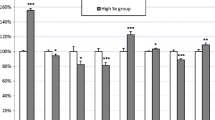Abstract
Objective. More than 35 years ago, during 1965–1968, in the former Czechoslovakia, approximately 80 persons became ill due to occupational exposure to 2,3,7,8-tetrachlordibenzo-p-dioxin (2,3,7,8-TCDD). The objective of this study was to investigate the incidence of disorders related to occupational exposure to 2,3,7,8-TCDD.
Methods. Most subjects in the group of 12 former 2,3,7,8-TCDD workers (mean age 56.8 years, exposure 10 days to 23 months) still suffer from disturbances of lipid metabolism, psychic disorders, chloracne, and/or nervous system lesions. All workers were given internal, neuropsychological and ophthalmological examinations. Blood cholesterol and triglycerides were measured, and the common carotid artery was examined by ultrasound (B-mode), with the intima-media thickness (IMT) also being measured. Findings were compared with the 2,3,7,8-TCDD level in 1996.
Results. Nine of the 12 previously exposed workers had elevated plasma lipids, and hyperlipidaemia was statistically more frequent in patients with higher 2,3,7,8-TCDD levels (P=0.03). Subject 1, with the highest 2,3,7,8-TCDD plasma level, had 80% stenosis of the diameter of the carotid artery, which needed acute surgery. Besides him, seven persons had atherosclerotic plaques in the carotid arteries. The mean IMT in the group was 0.85 mm (SD±0.19); the normal value is 0.62 mm. Eight subjects had degenerative changes of the ocular fundus. Chloracne was still present in two persons. Neuropsychological findings were assessed as normal only in three persons with lower 2,3,7,8-TCDD plasma levels in 1996. Mean 2,3,7,8-TCDD plasma level in 1996 was 256 pg g–1 fat (range 14–760).
Conclusion. Hyperlipidaemia, atherosclerotic plaques, increased IMT, ischaemic heart disease and neuropsychological disturbances were frequent in this group of former 2,3,7,8-TCDD workers. Hyperlipidaemia might have played an important role in most of these disorders. The level of 2,3,7,8-TCDD correlated with the highest level of triglycerides (P=0.02) and cholesterol (P=0.01) that was found during the 35-year follow-up. This group belongs to the most heavily 2,3,7,8-TCDD-exposed groups of workers, because the mean estimated concentration at the time of intoxication was approximately 5,000 pg g–1 plasma fat.
Similar content being viewed by others
Author information
Authors and Affiliations
Additional information
Electronic Publication
Rights and permissions
About this article
Cite this article
Pelclová, .D., Fenclová, .Z., Preiss, .J. et al. Lipid metabolism and neuropsychological follow-up study of workers exposed to 2,3,7,8- tetrachlordibenzo-p-dioxin. Int Arch Occup Environ Health 75 (Suppl 1), 60–66 (2002). https://doi.org/10.1007/s00420-002-0350-4
Issue Date:
DOI: https://doi.org/10.1007/s00420-002-0350-4




